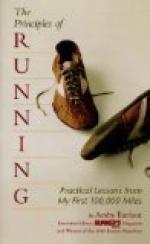“Pass back word to the men,” groans Captain Blaikie, “to march at attention, put their caps straight, and slope their shovels properly. And send an orderly to that hilltop to look out for General Willis. Tell him to unlace his boots when he gets there, and on no account to admit that he knows how to make a sea-pie!”
IX
MID-CHANNEL
The Great War has been terribly hard on the text-books.
When we began to dig trenches, many weeks ago, we always selected a site with a good field of fire.
“No good putting your trenches,” said the text-book, “where you can’t see the enemy.”
This seemed only common-sense; so we dug our trenches in open plains, or on the forward slope of a hill, where we could command the enemy’s movements up to two thousand yards.
Another maxim which we were urged to take to heart was—When not entrenched, always take advantage of natural cover of any kind; such as farm buildings, plantations, and railway embankments.
We were also given practice in describing and recognising inconspicuous targets at long range, in order to be able to harass the enemy the moment he showed himself.
Well, recently generals and staff officers have been coming home from the front and giving us lectures. We regard most lectures as a “fatigue”—but not these. We have learned more from these quiet-mannered, tired-looking men in a brief hour than from all the manuals that ever came out of Gale and Poldens’. We have heard the history of the War from the inside. We know why our Army retreated from Mons; we know what prevented the relief of Antwerp. But above all, we have learned to revise some of our most cherished theories.
Briefly, the amended version of the law and the prophets comes to this:—
Never, under any circumstances, place your trenches where you can see the enemy a long way off. If you do, he will inevitably see you too, and will shell you out of them in no time. You need not be afraid of being rushed; a field of fire of two hundred yards or so will be sufficient to wipe him off the face of the earth.
Never, under any circumstances, take cover in farm buildings, or plantations, or behind railway embankments, or in any place likely to be marked on a large-scale map. Their position and range are known to a yard. Your safest place is the middle of an open plain or ploughed field. There it will be more difficult for the enemy’s range-takers to gauge your exact distance.
In musketry, concentrate all your energies on taking care of your rifle and practising “rapid.” You will seldom have to fire over a greater distance than two hundred yards; and at that range British rapid fire is the most dreadful medium of destruction yet devised in warfare.
All this scraps a good deal of laboriously acquired learning, but it rings true. So we site our trenches now according to the lessons taught us by the bitter experience of others.




